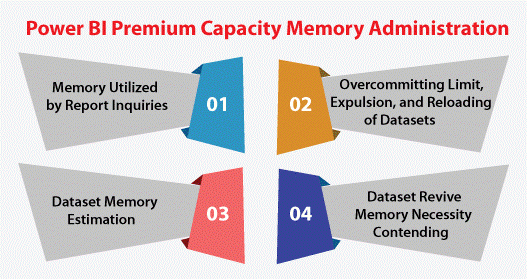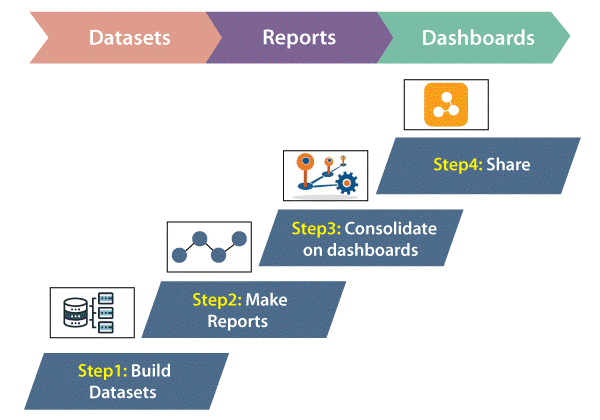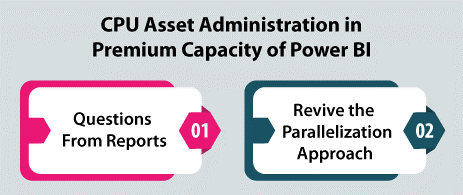Power BI Premium Capacity
(Of Resource arrangement, Optimization and effective Management)
Usage and capacity of Power BI Premium
Power BI Premium gives resources for running the Power BI application for your associated work, giving you more time tested execution and greater data volumes. Premium furthermore engages in all cases allocation of substance without anticipating that you should purchase per-customer licenses for watchers.
- You can take advantage of Power BI Premium by giving out work areas to a Premium usage.
- A Power BI Premium capacity is a limited resource for your affiliated work. For work areas that not permitted to an extraordinary activity, these will in a typical limit of Power BI Premium.
- A common limit is an regular limitation you use with Power BI, where your responsibilities continue to execute on computational sources given by various customers.
- As far as possible, more restrictions are put on particular customers to ensure the idea of the experience for all customers.
Memory Administration of Power BI Premium Capacity
Power BI Premium limit memory is eaten up by:

a. Memory Utilized by Report Inquiries
Exactly when any request is placed against an appropriated dataset in your capacity, that dataset is stacked into memory from consistent accumulating (this is also called picture stack). Keeping the dataset stacked in memory urges fast response to future inquiries to this dataset.
Regardless the memory needed for storing the dataset in the RAM memory, report requests and dataset fortifies moreover exhaust additional memory.
b. Dataset Memory Estimation
When trying to stack a dataset into memory, Power BI checks the proportion of memory that dataset will need to complete the requested calling. Datasets in memory tend to greater in gauge when extra to circle. In the midst of strengthen of a dataset, RAM limit needs no under twofold the proportion of memory than needed when it is out of range.
c. Reloading of Datasets, Overcommitting Limit, and Expulsion.
The potential gain of overcommitting is offered by Power BI Premium limit. For example, you can circulate more datasets than memory can hold. In case of the dispersed datasets, it needs more RAM to can fit in the breaking point. A piece of the datasets will take care of autonomously in an enterprising storing. The resolute storing is a piece of 100 TBs accumulating identified with all of your capacities.
Question: when all things are considered then which datasets is left over in memory and what is the substitute datasets for the final product?
Answer:
- As it is said previously, when an issue is raised against a dataset, it stacks into memory. The request could form a report request or a resuscitate task.
- Since we can overcommit our capacity, our capacity limit may similarly go up against memory weight. Exactly when memory weight is reduced (because another dataset should stack or the inquiries on some stacked datasets increase the memory essential), the middle part gets expelled no less than one datasets including the cut-off memory.
- Datasets that are inactive (for example there is no doubt/resuscitate movement at this point executing) is in a LRU (Least recently used) way. If new orders are issued then it gets assigned to the eliminated dataset.
- The organization tries to reload this into memory, potentially removing distinctive datasets. This directly considers more capability to use, with the capacity to serve various datasets than its memory can hold.

Memory management in RAM
Memory management is an expansive term that consolidates all cycles of management and approaches for the monitoring, allotment, checking of PC memory.
Memory management permits a hidden PC or working framework (OS) to powerfully disperse memory across every single running cycle, while guaranteeing ideal execution of an instruction.
Memory management manages the administration of a PC's actual memory or irregular access memory (RAM). Ordinarily, every PC has preinstalled primary memory, which is utilized for preparing running application and administrations. Regardless of how extraordinary memory limit is, it can't oblige all prepared/running projects or cycles at the same time. Hence, memory management dispenses important memory space for each interaction, moving it in the middle of hard drive and memory, and appointing needs and the general association of the projects/measures. Memory the board is generally performed and overseen by the host working framework.
Memory the executives likewise envelops other non-unstable recollections inside a framework, for example, store memory and virtual memory.
Let’s now look how memory management is done in the context of power bi.
- Stacking any particular dataset into RAM is a really costly undertaking.
- A Power BI Premium limit tries to restrict the conditions the breaking point should stack by keeping the smallest actually used datasets in memory for whatever timeframe that possible.
- Exactly when additional memory requires, some datasets ought to out and the system will try to pick the one that has negligible impact on the customer experience.
- Exactly when additional memory requires, some datasets ought to remove and the structure will attempt to pick the one that has insignificant impact on the customer experience.
- For example, the structure will go without expelling datasets which were successfully used inside the latest several minutes, since they are likely going to address again soon.
- The evacuation methodology itself is a fast assignment. If the dataset isn't in unique use at the period of expelling, the customer will not have the ability to choose a lot of impact from the ejection.
- In any case, if exorbitantly various datasets are in powerful use meanwhile and there isn't adequate memory to hold them all of them, a significant proportion of ejections can occur.
- This can provoke a 'whipping' situation, where datasets are continually eliminating and once again stacked, and customers could see a discernible drop likewise times and execution.
d. Dataset Revive Memory Necessity Contending
- Datasets can resuscitate on a schedule or on-demand by customers. As mentioned previously, the memory needed for full resuscitates no under twofold the memory size of the stacked stand by datasets.
- Prior to restoring starts, an empower memory essential asses.
- In case the total memory essential is more than the open memory in the breaking point, some datasets are expelled. Competitor for expelling picked in the solicitation of smallest actually used datasets.
- Advantage of efforts to keep whatever number actually used datasets as could expect considering the present situation in the memory.
- In case the necessary memory isn't available paying little heed to ejection, the restore line up to retry. The organization retries until the moment that it succeeds or another stimulate movement begins.
- If a natural inquiry issue to any dataset in the breaking point and there isn't adequate memory open because of a ceaseless strengthen. That request misfires and ought to retry by the customer.
Premium Capacity of Microsoft Power BI (Central processor Administration)
There are two mandatory sections of CPU assets:
>>inquiries from reports
>> Resuscitate the methodology of Parallelization

a. Inquiries (or questions) from Reports: Report questions eat up CPU resources of your capacity. If your report has a couple of inquiries that are inefficient or if you have various synchronous customers. It can exhaust an impressive proportion of CPU resources and your present cut-off may not satisfactory to manage the store.
b. Reviving the methodology of Parallelization: Memory isn't the essential asset that can ensure visualization of datasets. The v-cores can be a likely factor. Since each task requires a specific number of different v-cores to finish the task. There is a prerequisite concerning what number of v-cores model number, can keep on running the task in equivalent.
Note:
- In this context SKU is used as synonym to "Licencing Option". In general (different areas) SKU is equal to “Stock Keeping Unit”. Which is basically company’s internal number which is used to keep record of number of stocks.
- Model number of refresh parallelism means refresh rate of CPU.
- Backend type of V-Cores: Backend v-cores are physical computing nodes in the cloud, in the original version of Power BI Premium. With contrasts in the quantity of v-cores and the measure of locally available memory as per the client's authorizing SKU. Clients were needed to monitor how bustling these nodes in the cloud were utilizing the Premium measurements application.
The cut-off limit per SKU is shown in the table with parallel model number refresh rate.
| Backend type of V-Cores | SKU model number | Model no. refresh parallelism |
| V-Cores: 1 | model number: A2 | 2 |
| V-Cores: 16 | model number: p3 | 24 |
| V-Cores: 2 | model number: EM3 | 3 |
| V-Cores: 8 | model number: p2 | 12 |
| V-Cores: 4 | model number: A4 | 6 |
| V-Cores: 0.5 | model number: EM1 | 1 |
| V-Cores: 1 | model number: EM2 | 2 |
| V-Cores: 32 | model number: P4 | 48 |
| V-Cores: 16 | model number: A6 | 24 |
| V-Cores: 0.5 | model number: A1 | 1 |
| V-Cores: 2 | model number: A3 | 3 |
| V-Cores: 4 | model number: P1 | 6 |
| V-Cores: 8 | model number: A5 | 12 |
| V-Cores: 64 | model number: P5 | 96 |
Tip – if the restores are getting concede, check the amount of equal animates reinforced by your capacity.